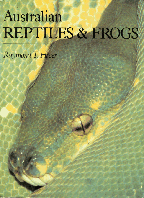 CAPTURING REPTILES AND FROGS.
CAPTURING REPTILES AND FROGS.
Most reptiles and frogs are usually ambushed as they try to make an escape, and are simply 'grabbed'. A number of tools used by people to capture reptiles and frogs have already been listed including, CARS for road hunting, SPOTLIGHTS for frogs and some nocturnal reptiles, CASSETTE PLAYER for attracting frogs, TRAINED DOG/S for terrestrial reptiles, FISHING GEAR including NETS for aquatic reptiles and tadpoles, DIVING EQUIPMENT for other aquatic reptiles.
When attempting to capture a given reptile, most collectors will improvise and use available aids as necessary, including some of the following.
CROWBARS and JACKS are useful in lifting large rocks which would otherwise not be movable when reptiles are known to be hiding under them.
PRODDING WIRES can be used to poke reptiles out of rock crevices by prodding them in sensitive areas such as the neck and behind the limbs.
Often collectors will use the nearest stick to poke a reptile from a crevice.
SHOVELS and RAKES are useful for digging out burrows and sifting through leaf litter when a reptile has taken cover. AXES and SAWS are useful for extracting reptiles from logs, and tree branches, although they are highly destructive.
RUBBER BANDS and SLING SHOTS can be used to stun lizards that won't allow one to approach too close.
GUNS can be used to obtain reptiles that are not necessarily needed alive, (for example a museum collection), although the use of guns for capturing/killing reptiles should be discouraged.
A NOOSE is useful for obtaining otherwise inaccessible reptiles such as Goannas in trees. A noose is essentially a loop of rope at the end of a pole that will tighten when pulled. When the loop is slipped over the lizard's head and yanked, it tightens, allowing the lizard to be pulled from the tree. When in the middle of bushland with few tools a noose can be made from a long stick with a piece of string at one end with a slip knot tied.
TRAPS such as modified 'possum traps' which rely on bait to capture a reptile may be used for larger monitors, but usually with limited success.
Smaller bait traps for skinks have been used with limited success by some collectors.
PIT TRAPS which are specially dug holes into which reptiles fall are usually of minor success. These traps are dug along lines where many reptiles apparently 'walk'. DRIFT FENCES or BARRIERS may be used to direct reptiles towards the pit traps, which may in turn be baited with the anticipated food of the lizard/s to be caught. Another disadvantage of these traps is that they need to be 1/ Specifically constructed in the first place, and 2/ Checked frequently to be of any success.
SNAKE STICKS (including 'JIGGERS') come in a variety of forms. The traditional forked stick used to pin snakes by the head is generally not used because 1/ It can cause injury to a snake, and 2/ It is hard to have a stick on hand that is the 'same size' as the snake. Modern snake sticks (Jiggers) consist of a fork at the end, with a stiff rubber across the fork. Snakes can be pinned with this apparatus and then picked up relatively safely. Variations of this form do occur. A stick with a hook at the end, is rarely useful for capturing wild snakes, although it is excellent for handling captive snakes which are more docile and less likely to actively flee when handled.
A number of other tools for capturing reptiles and frogs are sometimes used, and the variety is only limited by the inovativeness of reptile and frog collectors.
To continue to the rest of this section

The above was from the book Australian Reptiles and Frogs by Raymond Hoser and now available on a fantastic CD-Rom along with a vast amount of other information, papers and the like on reptiles, frogs and other wildlife.